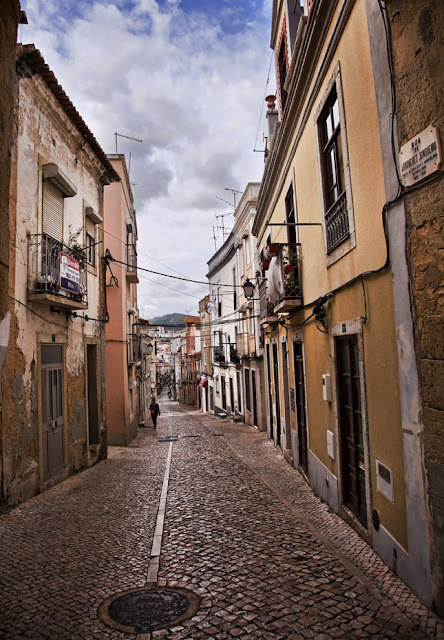 |
| As you can see there was a bit of colour in the sky but not a great deal |
 |
| This is one of those 'why not' shots, it's just a cloudy sky but why not take a picture of it anyway? |
But where we walked certainly wasn’t ancient, towered over by the Tróia Design Hotel and casino next door, it was nothing if not striking. Though not the easiest resort to build however as construction had to be abandoned when it was discovered that the entire area was unstable and actually sinking, which is not a good look for any resort, the hotel itself was the subject of major preventative work upon completion when it started to pitch alarmingly, and for a while looked like it was going to topple, so to speak, the Leaning Tower of Pisa for most rakishly angled building.
But that is all a thing of the past, fingers crossed, as it now, along with being the very definition of vertical, boasts stylish decking, trendy cafes and restaurants that line the promenade at street level, although they were somewhat marred by the incongruous inclusion of a kebab shop bang in the middle, which was puzzling to say the least, but fair play to them, even at 10 am it was open and ready for business. How popular kebabs are at this time in the morning is, I think, open to debate, but I admired their optimism, if not their cuisine.
Once on the boat it was a case of shoot, shoot, shoot, with the camera I hasten to add, we were not on a hunting expedition, although it would’ve soon wiped the infuriating smiles off their beaming faces if we were. But to give them their due, they gamboled and frolicked for all their worth and I was soon racing through my memory cards trying to keep up with their water-logged antics.
 |
| This fella seemed to be blowing a raspberry at us by the look of that air bubble |
 |
| A rather minimalist view of Troia from the boat as we headed back to shore |
 |
| The chimneys of this petrol refinery under low cloud looked quite picturesque |
After disembarking we headed straight to the central market, where we were presented with a cornucopia of natural produce, rows upon rows of fresh fruit and vegetables, all colours, sizes and shapes, but as attractive as they were it was not these that had drawn us, it was the fish that held court for us this morning. We were not disappointed, there were so many variations, many I had never seen before, it was like visiting Sea World, but with all the species laid out on slabs, and dead.
So it was like visiting a Sea World that was run by a deranged lunatic whose only means of venting his frenzied mania was to butcher, dismember and eviscerate anything remotely piscine, then lay out the defiled remains on marble alters as a perverted exaltation to madness. But on the plus side, once these animals had been at the receiving end of such an outrage, they were very interesting to look at, and of course good to eat. So all’s well that ends well.
 |
| Snapped on my phone, these unfortunate beasts may have met their fate at the hands of a maniac but they certainly looked appetising |
 |
| Looking down through one of the city gates (gate not included) |
 |
| Looking up towards one of the city gates (gate included) |
We then left to get the ferry back to Tróia except that we missed it, so we went and got another coffee, which is never a bad thing as the coffee so far had been excellent, not a bad cup among them, which always pleases me. So once we’d managed to actually get the ferry and reunite ourselves with the car we drove to the local Roman Ruins, the aforementioned largest fish salting plant in Europe, which was very exciting, right up until the point we got to the entrance gate, and discovered it was closed.
Turns out they were doing some restoration work which meant it would be closed from that Thursday, which was slightly mystifying for us as it was only Tuesday. So after checking the opening times, which categorically stated that it was fully open for business that day, we could do nothing else but get back in the car and glide gracefully away as I permitted myself a rye smile, a small shake of the head and thought, ‘those crazy Portuguese’.
I whiled away the remainder of the day by having a nap, watching the evening rain, which put paid to any ideas of a sunset shoot, and eating dinner, before retiring for the night.
Your first two photos, in particular, Martyn, are magnificent. All of this piece is wonderful. What a place to be in!
ReplyDeleteThanks so much, glad you're enjoying the blog.
ReplyDelete